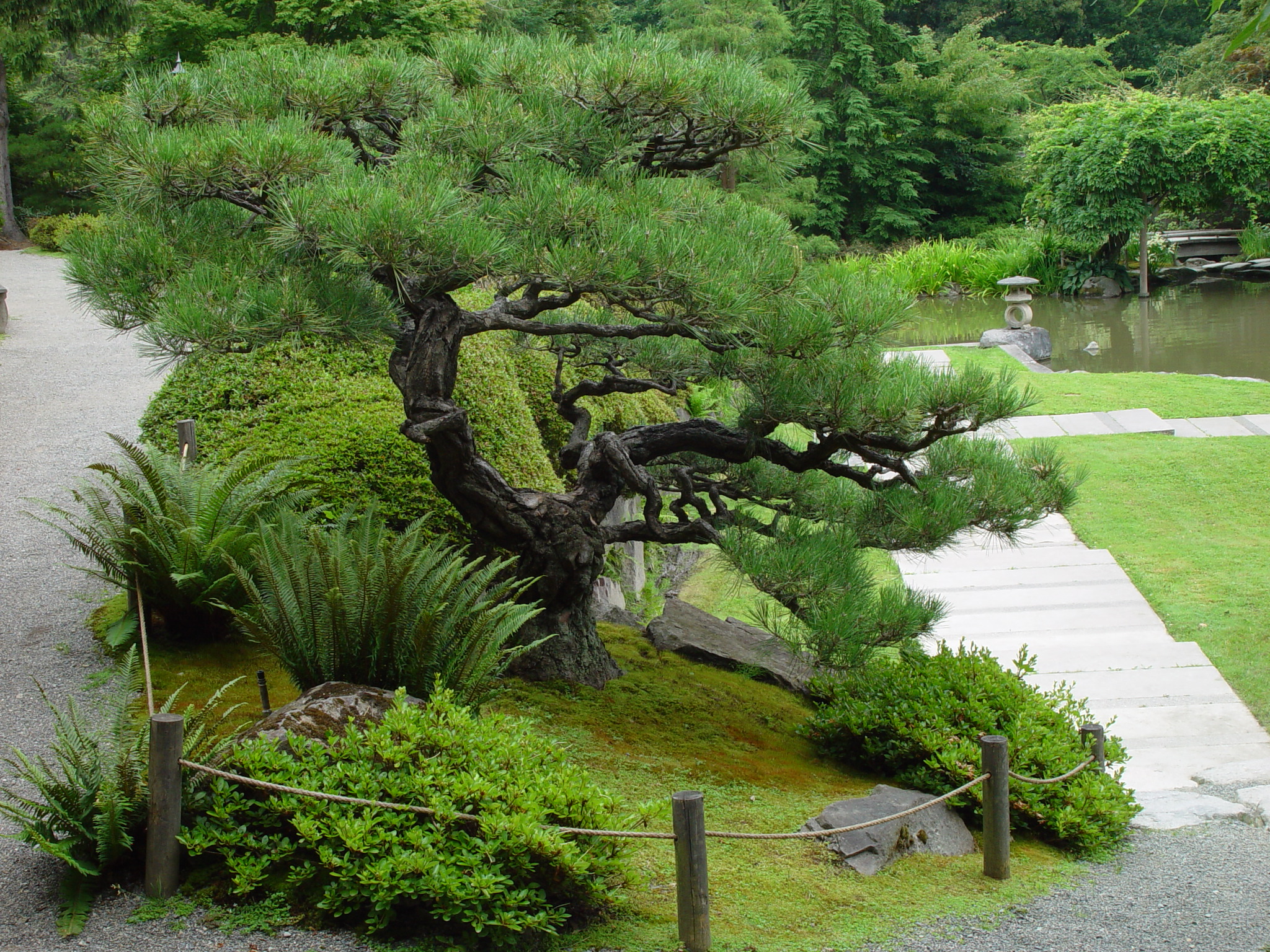Pine Trees, Part One: Beloved Conifers
By Corinne Kennedy
Pinus thunbergii, over 100 years old. It was donated by Richard Yamasaki and moved to the Seattle Japanese Garden in 1993. (photo: Seattle Parks, 2007)
Pine trees are well-known and beloved evergreen conifers (cone-bearing woody plants), renowned for their toughness and adaptability. They’ve been the subject of stories & legends over millennia, and even today are important cultural symbols throughout the northern hemisphere. Although they grow in both temperate & subtropical regions, most species tolerate cold temperatures, poor rocky soil, wind and drought. They also develop striking character with age, especially with skillful pruning or the effects of temperature & wind.
Pines are the most dominant native plant in Japan and the most important tree in Japanese gardens. Known as matsu, they are strongly associated with Japan’s original religion, Shintoism, which viewed pines as yorishiro – that is, a place capable of attracting the gods (kami). In fact, the word matsu means “waiting for a god’s soul to descend from heaven.” Here, in the Seattle Japanese Garden, there are many pine species & hybrids, most located near the central pond & on its islands, and on the hillside at the garden’s north end.
The genus Pinus
The genus Pinus (family Pinaceae) has a long history, dating to the early Cretaceous or Jurassic Period, about 130-200 million years ago. More than 100 species exist today, in habitats ranging from sea level to treeline. Growth habits include low prostrate forms, small to medium-sized rounded shrubs and tall narrow trees, some exceeding 250 feet in height. Young trees of the taller species tend to be pyramidal, becoming more open, flat-topped and picturesque with age. Countries with the most species are Mexico (about 60), the U.S. (about 45) and China (about 21).
Unlike some conifers, pine trees are shade-intolerant. They require sun & well-drained soil, and are among the first trees to establish in open ground, such as areas disturbed by fire. They’re often found in open sites or pure stands where fire and drought limit plant density, and so they seldom dominate in “climax community” forests.
Most species are long-lived. Under favorable conditions, a pine may live for 100 years or longer – perhaps even 400 years. In fact, the oldest living tree of any species is an intermountain bristlecone pine (Pinus longaeva; sometimes known as Pinus aristata var. longaeva) over 5,000 years old.
Pine foliage is needle-shaped and held in clusters (bundles known as fascicles) attached to the branches. Depending upon the species, the bundles consist of 2, 3 or 5 needles held together by sheaths at their base. They seldom occur singly or in larger multiples. They’re held for at least 2 years – and in some species, much longer -- after which older needles are shed. The narrow shape prevents heavy snow accumulation and consequent branch breakage. In all species, needles are coated with a waxlike substance (cutin) that inhibits water evaporation and protects cells from freezing. New branches develop each year in a circle (whorl) around the trunk. Bark is typically thick, rough, and furrowed or scaly.
As conifers, Pinus species produce cones -- dry fruits consisting of a central stalk surrounded by overlapping woody scales which separate to release the seeds. Pines are monoecious – that is, individual trees produce both male and female cones. The former release pollen, which is spread by gravity and wind. Female cones are larger, with seeds contained between the scales. Species with large seeds, known as “pine nuts,” are prized as sources of food.
Many of the larger pine species are valued as timber and fuel. The resin that protects them from insects & fungal infections, and forms a protective callus over wounds, is used to produce other useful products, including turpentine, pine-wood oils and wood tars.
Woodblock print by Ando Hiroshige (1797-1858). From the series 100 Views of Edo. (Library of Congress collection: Japanese Fine Prints & Drawings, pre-1915)
Pines in Japan
In Japan, matsu are associated with endurance & longevity -- not simply because pines are evergreen and long-lived, but also because of the mythic/poetic image of pine-covered Mount Horai, the “island of the Eight Immortals.” Matsu is also the pronunciation of the verb “to wait,” and in Heian era poetry was strongly associated with waiting for a lover. More broadly, pine trees suggest the idea of waiting for a difficult situation to be resolved.
Representations of matsu are iconic in Japan, where pines are immortalized in everyday objects as well as in art & literature. Before the New Year, a pair of decorations known as kadomatsu (translated as “gate pine”) are placed on either side of household & business entrances as a temporary home for the kami. Matsukawabishi is a geometric design motif, appearing on fabrics textile art, that represents the patterning of matsu bark, which is thick & scaly. Of even greater importance are matsu images in literature and works of art – such as poetry, woodblock prints, and the kagami-ita, the back wall used in Noh theatre.
The two species of pine most important in Japanese gardens are two-needle forms. These two species are Pinus thunbergii (kuro matsu, translated as “Japanese black pine,” and a seacoast native) and Pinus densiflora (aka matsu, translated as Japanese red pine, and native to low mountains & hillsides). In gardens, they’re traditionally used to represent these native habitats. Part Two of this series, to be published next month, discusses each in detail -- and examines how pines and their maintenance are central to the aesthetic of the Seattle Japanese Garden.
Corinne Kennedy is a Garden Guide, frequent contributor to the Seattle Japanese Garden blog, and retired garden designer.


